If you read this article here, you must have protected your PC with a security suite or at least an antivirus program. Maybe you’re security conscious enough to protect your Mac with an antivirus program. But for truly comprehensive security, you need to extend protection to mobile devices that take up a lot of your attention. Trend Micro Maximum Security provides advanced protection for Windows and Android devices, going beyond the basics of macOS and even the security offered by most competitors for iOS. Your safety is guaranteed regardless of the platform.
Trend Micro products come with a fixed number of licenses. You get one antivirus license, three for the entry-level suite, five for maximum security (check it out here), and 10 for top-level premium security.
Unlimited security and VPN licenses. As with Trend Micro, you can’t just buy more licenses – you have to upgrade to a higher quality product.
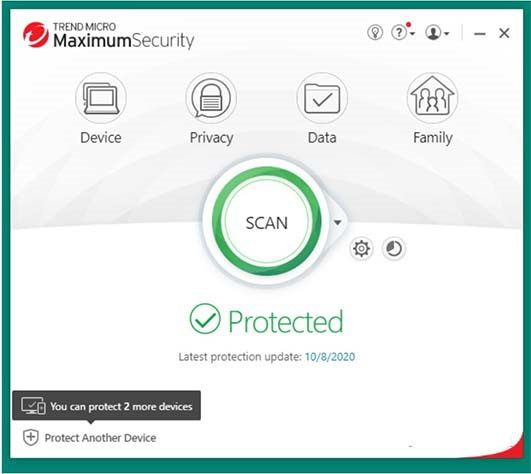
Without the program title in the upper left corner, you won’t be able to distinguish this large suite of Windows protection from Trend Micro’s entry-level suite or the standalone Trend Micro antivirus. A large scan button in the center anchors the main window, and four circular icons at the top give you access to four groups of security features: Device, Privacy, Data, and Home. As you might expect, this Windows suite’s extras, advanced password manager, and file encryption library are all displayed on the data page.
Features Shared With Antivirus
Every app in Trend Micro’s product line is fully comprised of the next smaller component, such as a collection of nesting dolls. All the features of Trend Micro Antivirus+ Security are included in this suite. For a full overview of these common features, you can read my antivirus review. If you just need the abstract, keep reading.
All four antivirus testing labs we track include Trend Micro in their reports, and it received a range of ratings from perfect to failing (though the failing tests used Trend Micro’s enterprise-grade products). Its overall lab score of 8.5 was the lowest among all four lab-tested products. On the other hand, all four felt that the product was important enough to deserve their attention. In the past, things were much better.
Kaspersky Security Cloud and Norton both scored 9.7 points, currently the highest score in all four lab tests. Bitdefender tops the list with an overall score of 9.8, although this is based on just three labs.
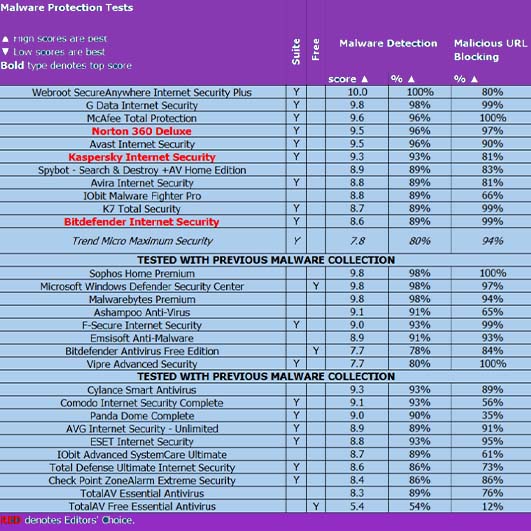
In our hands-on antimalware tests, Trend Micro didn’t fare nearly as well. In the lower range with a score of 7.8. Bitdefender also scored relatively low on this test, but it more than made up for it with its excellent lab results.
Webroot Secure Anywhere Internet Security Complete was tested with the same sample and scored a perfect 10. G Data came close with a score of 9.8.
To see how each antivirus handles the latest malware, we used a collection of 100 malware-hosting URLs recently discovered in the wild. Trend Micro blocks 94 percent of malware downloads, almost all by blocking browser access to malware-hosting sites. McAfee Total Protection, Sophos, and Vipre currently have this test, each with 100% perfection, but Trend Micro’s 94% isn’t too bad.
Phishing sites do not attempt to install malware on your system. Instead, they masquerade themselves as sensitive websites and hope to steal your credentials. In my last test, Trend Micro achieved 100% protection in my anti-phishing test, which used a recent real-world phishing site. This time it caught 96%. That’s still a good result, but six products did better. In particular, Bitdefender Total Security McAfee and Norton each intercepted 99% of samples in their phishing tests.

The product offers three different levels of ransomware protection. Folder protection prevents unauthorized programs from changing the folders you want to protect. It monitors all processes for signs of ransomware-like behavior. If the ransomware manages to corrupt files before acting on the system to delete them, it recovers those files from encrypted storage. When we rolled out a set of ransomware samples that had been manually tuned to avoid simple signature-based detection, Trend Micro caught them all based on their behavior and flagged half of them as ransomware and the rest as suspicious.
Other common features include: Pay Guard, a hardened browser for financial transactions; silent mode that suspends all security-related interruptions; Windows Firewall Booster for network layer attacks; Fraud Buster, which sends your email to Trending Technology for analytics and fraud detection; and link tagging to identify suspicious or dangerous links in search results and social media. These impressive feature sets make Trend Micro Antivirus+ Security a “plus”.
Shared Suite Features
Trend Micro Antivirus is available as a single license for Windows or macOS, with no discount for multiple licenses. Upgrade to Trend Micro Internet Security and you get three licenses for use on a PC or Mac. Read my entry-level kit review for all the fun details. I will summarize here.
The suite’s PC Health Check checks your system to find ways to improve security and performance. These include, but are not limited to, junk files that waste disk space, traces of browsing history, and startup programs that slow down the startup process.
For another privacy view, the social media privacy scanner checks your Facebook, Twitter, and LinkedIn accounts and reports any settings that might compromise your privacy. Tested and it reported no security issues in my Facebook and LinkedIn accounts, as expected. However, if I had followed his Twitter advice, I would have cut myself off from my public audience.
Parental controls in Trend Micro
Parental controls in Trend Micro are limited and ineffective. It lets parents control when and when their kids can use the internet, and can set time limits on programs, such as preventing them from playing during homework hours. Previously, content filters proved to be completely porous, unable to filter secure HTTPS websites. This has been fixed, although HTTPS pages will still pass the filter in any unsupported browser. A component designed to mask offensive imagery proved ineffective in its own way.
A file shredder utility
With the starter kit, you get a shredder utility that wipes files so thoroughly that not even forensic hardware can get them back. This becomes even more important in this large suite, where you can use a shredder to delete plain-text copies of files that have been stored encrypted. More on encryption below.
There are things you just don’t want to share online, whether it’s your kids giving away your home address or a spyware program trying to send your credit card details back to malware headquarters. You can configure Trend Micro to prevent the transfer of any data you designate as private. The last time I tested this feature, I found that it did not filter data sent to HTTPS websites (or, I assume, sent by spyware over HTTPS connections). Fortunately it works fine now. Entry-level kits are just that.
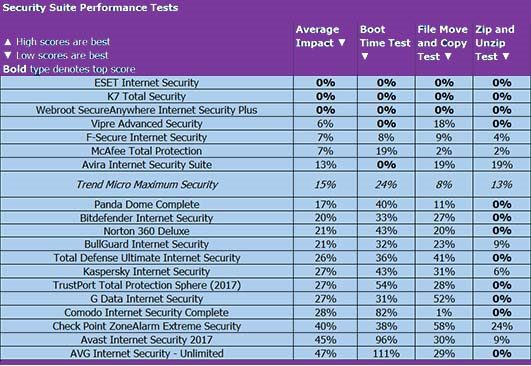
You might think that the plethora of new features shared with antivirus software might make the app slow and degrade system performance. You would be wrong. The boot process took 24% longer than we tested without the suite and with Trend Micro installed, but 24% of the real-time time was just under a minute. Our tests for moving and copying files and for compressing and decompressing files took 8% and 13% of the time, respectively. It’s true that ESET, K7 Ultimate Security, and Webroot showed no resistance at all in these tests, but Trend Micro’s minimal slowdown isn’t something you’ll notice.
Encrypted Vault Storage
On the data side, this top-notch suite adds a file encryption system called Vault. This type of encrypted storage of sensitive files is a common feature in security suites. ESET, G Data Total Security, Kaspersky, and McAfee are all suites that offer file encryption. All of these allow you to create multiple encrypted storage containers, each with a capacity determined at creation time. Trend Micro takes a different approach.
For starters, Trend Micro will only create one vault whose capacity will expand as needed. When using the vault for the first time, define a password to protect its contents, as well as a password hint and email address for password recovery. No need to enter a name or identity like everyone else. Once a vault is open, you can use it like any other folder, with one small exception – you can move files in and out of the vault, but you cannot use the right-click menu to create new files in the vault. Lock the vault, you have blocked all access to encrypted files.
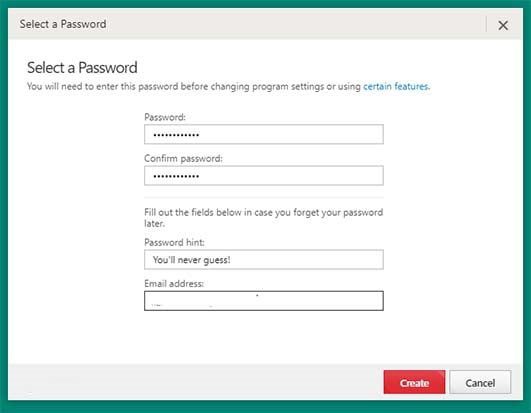
Be careful with email-based password recovery systems. Instead of the usual time-limited recovery link, Trend Micro simply blurts out your actual password in plain text. If you must use email-based recovery, please change your password later. Also note that for some reason you can only use letters and numbers in your password, not special characters.
Ensuring maximum security for your files is a two-step process. First, copy the file to the clipboard and paste it into the Vault. Do not drag files in, as this will only delete the original files. Second, use Secure Erase to erase the original. Otherwise, snoopers (or government agencies) may be able to recover unencrypted files.
Here comes the best part. If your laptop is lost or stolen, you can log into Trend Micro online and seal the vault so even the password cannot open it. This laptop thief can try to guess the password until the sun rises; it doesn’t work. If you are lucky enough to recover your laptop, you can log back into Trend Micro and open the vault.
Limited Password Manager
Keep your eyes open when installing this kit. There’s a subtle checkbox on the license agreement page that tells the installer to also add the Trend Micro Password Manager. You can install it later, but the easiest way is to install it during suite installation.
A few small changes have occurred since we last reviewed this password manager. It now supports Microsoft Edge in Windows 10 and includes an option to open any saved website with Pay Guard. It is now available as a Safari extension for macOS. On Android, the free version can run in local mode without a Trend Micro account. that’s it.
We reviewed the product as a standalone tool and found it lacking. Yes, it covers the basics and syncs data across all your Windows, macOS, Android and iOS devices. But it missed some logins in testing and lacked advanced features like password inheritance and secure sharing. Granted, this suite is free, but the best completely free password managers outperform it.
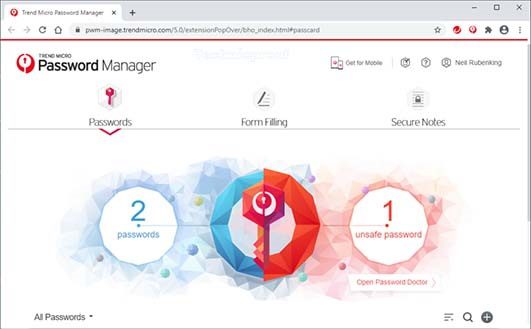
Security for Your Mac
If you have some licenses left after securing all your PCs, you can use them to install Trend Micro Antivirus for Mac. It’s not as feature-rich as the Windows suite, but it includes more than the most basic functions. Read my review for a comprehensive look at Trend Micro’s macOS protection.
Trend Micro is one of the few products to score macOS products in both antivirus testing labs; Avira Free Antivirus for Mac also managed to achieve this feat. Folder Shield on Mac works the same way as on PC, although it doesn’t get help from other ransomware protection layers. A few other features don’t quite add up. Parental control content filters can now handle HTTPS sites, but content filtering is what parental controls are all about. And the webcam privacy monitor is so limited that it’s useless. Read my review again for all the details.
Mobile Security for Android
Trend Micro Internet Security supports Windows and macOS devices, while Maximum Security, reviewed here, adds support for Android and iOS. At the bottom left of the main window is a link titled “Protect Another Device,” and the app usually adds a tooltip that highlights the link and reminds you how many licenses you have left. Click this link, click one of the available slots, select the device type, and you’re good to go.
For Android devices, you get three sharing options. You can have the app email you the link, copy the link to the clipboard to share it in other ways, or display a QR code. I scanned the code and quickly installed Trend Micro on the Moto G5 Plus I used for testing. I have to be logged into my Trend Micro account to enable full protection; the account connection is not burned to the URL.
Android Lab Results Excellent
I follow four independent test labs to rate Windows antivirus products. Three of them also tested security measures on Android, and Trend Micro got perfect results on two of them.
Researchers from the AV-Test Institute(Opens in a new window) regularly test Android security programs and rate them based on protection, performance, and usability. Products can earn 6 points in each category, up to a maximum of 18 points. Like just over half of the products tested, Trend Micro received a perfect 18.
AV-Comparatives(Opens in a new window) also publishes regular reports on Android security effectiveness. Several products achieved 99.9% protection; Trend Micro and Bitdefender were the only companies to achieve 100%.
Getting Started on Android
Like most Android security tools, I had to give the app some permissions, but it very neatly walked me through the necessary steps. It also directed me to enable a number of features, including Web Guard, Wi-Fi Checker, Lost Device Protection, and an optional parental control system. After completing or actively ignoring each point, the scan button in the main window turned from yellow to green and the status light showed I was protected. Clicking this button initiates a malware scan, which completes in a few seconds.
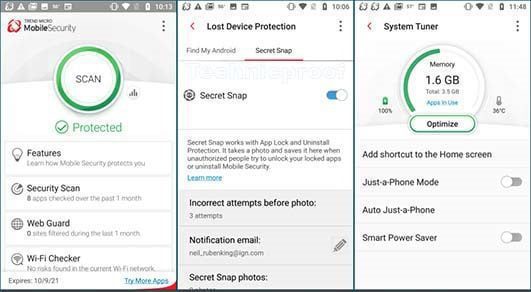
Below the scan button, the application’s main window scrolls through panels representing the nine main security components: Security Scan, Web Guard (replaces Safesurfing), Wi-Fi Checker, Pay Guard Mobile, System Tuner, App Manager, Parental Controls, Social Network data protection and device loss protection. New items at the top of the list will guide you through the app’s capabilities.
If you click on Security Scan, you will see the settings for the malware scanner. There’s a slider to change the overall protection from the default Normal to High or Low, and a checkbox to enable real-time protection and memory card scanning. This is also where you configure updates and check scan history if needed.
Lost Device Protection
Preventing device loss is as important to Android security as antivirus scanning. You can use Trend Micro’s online portal to locate, lock or wipe a lost or stolen device. If you just misplaced the device somewhere in the house, a loud alarm will help find it.
The icon labeled reset makes me think that in addition to removing personal data from the device, you can trigger a full factory reset. In fact it doesn’t. You can use Reset to force stop all running apps on your phone, preventing thieves from getting your phone while those apps are logged in. If Android Doze seems to have guessed or stolen your lock screen PIN, you can reset it remotely.
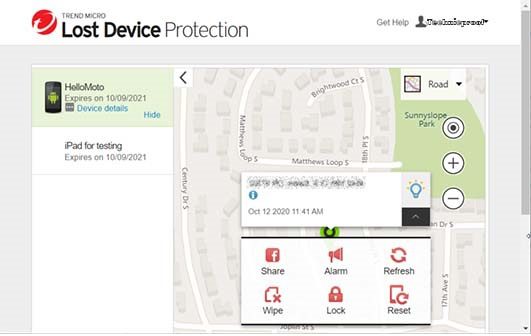
Within the app itself, you can edit the message displayed on locked devices and enable uninstall protection, which requires your Trend Micro password to uninstall the app. You can also configure the Secret Snap feature. Like similar features in McAfee Total Protection, Panda Dome Premium, and more, it secretly shoots anyone who repeatedly tries unsuccessfully to unlock or uninstall an app.
A Cornucopia of Android Features
Web Guard is a mobile application component that keeps you safe from malicious or fraudulent websites. As with the main malware scan, you can set it above or below the default level, but I’d leave that out. On my test Android, protection was automatically applied to Facebook, Instagram, Messages, Gmail, Messenger, and Chrome.
You can click to see what a site looks like when Web Guard blocks it. For further confirmation, I used the properly handled AMTSO feature check page (opens in a new window).
Enabling Wi-Fi Checker triggered a scan of my local Wi-Fi hotspot. Not surprisingly, no security flaws have been reported.
Pay Guard Mobile proved to be a lot of fun. On PC and Mac, Pay Guard is a protected browser that protects your online personal financial transactions. The Android version works differently. When you launch a banking app or other protected app, it verifies that the environment is secure and scans the Wi-Fi connection, the device, and the app itself. I don’t bank on my Android test device, but Pay Guard does add Prime Now to their protected list.
Like PC Health Check on Windows, the System Tuner app is designed to optimize your device’s performance, but with a simpler goal. First, it frees unused memory and reports how much is freed and how much battery life you gain. You can also use the App Freeze feature to force selected apps to stop all at once.
If your battery is near zero, you can turn on “Just-a-Phone” mode, which disables features like Wi-Fi and Bluetooth while allowing devices to make and call back. There’s also an option to automatically switch to Just-a-Phone mode when needed. Also in the System Performance section, App Manager lists all your apps and the resources they are using. If necessary, you can batch uninstall apps or disable preinstalled apps reversibly.
Under Parental Controls, you’ll find a dual approach. App Lock allows you to lock any app you don’t want to trigger while your child is playing with the phone. It only locks the settings by default; you’ll probably need to add at least mail, social media apps, and shopping apps. Unlocking requires your fingerprint or Trend Micro password. Bitdefender, Norton 360 Deluxe, McAfee, and others offer similar App Lock functionality.
Parental website filter blocks access to inappropriate websites that match the selected age: children, teens or teens. You can also configure specific categories to block to create custom profiles. I’m happy to see that content filters can handle HTTPS sites, so smart kids can’t disable filters by using a secure anonymous proxy.
Windows and macOS versions include a social network privacy scanner that checks for configuration issues in Facebook, Twitter, and LinkedIn. The same function on Android only checks Facebook and Twitter. As with other versions of the scanner, I have been advised to make my Twitter feed private, which affects how I use Twitter.
Comprehensive Android Security
Trend Micro doesn’t include phone-specific features like call and text blocking that McAfee, Kaspersky, and a few others are trying to do. I say try because the latest version of Android makes it harder for 3rd parties to spoof phones etc. This means that the app works the same on tablets and smartphones. Aside from the lack of those phone-related features, it’s a full-fledged Android security system with some unusual features.
Mobile Security for iOS
Securing iOS apps can be an issue with cross-platform security suites. The operating system itself is completely locked down, making it difficult for malware to attack, but also difficult for security products to defend against. Some companies just skip iOS protection, while others offer very little. Trend Micro’s iOS coverage is unusual.
You can add protection to your iOS device by sending an email, copying the link or scanning a QR code. I chose the third option and installed the app quickly.
Getting Started with iOS
As with Android, I found a to-do list to fix the full install. First, I enabled Web Guard, which promises to block unwanted ads and trackers using the local website filtering VPN component. Note that this does not connect to the VPN server, but provides a way to filter all web traffic. By default, only dangerous and deceptive websites are filtered out, but you can choose to enable parental controls. I go back to parental controls.
Next, I logged into my Trend Micro account to set up lost device protection. This has the added benefit of being able to enroll the iPad into my account and convert the installation from a limited time trial to a fully registered installation.
The three remaining tasks are logging into iCloud to allow apps to check my two-factor authentication status, and logging into Facebook and Twitter to allow social media privacy scanner access. As on other platforms, it considers my Facebook security safe and advises me not to make my Twitter public (which I don’t plan to do). As with Android, you can ignore recommended fixes to stop apps from nagging about them.
Whether the big scan button is orange or green, it’s not what you’d expect. It’s not a malware scan. Instead, it scrolls through all of the app’s features and looks for any issues that need fixing.
Below the scan button are eight panels that guide various security functions. Minus the settings window and windows that just explain other features, these are: Web Guard, Safesurfing, Fraud Buster, Social Network Privacy, Wi-Fi Checker, Data Usage, Device Access Status, and Device Loss Protection.
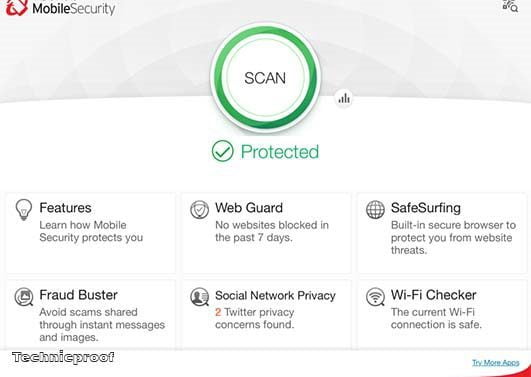
Fraud Buster on iOS
On Windows and Mac, Fraud Buster scans your web-based email for fraud by sending it to Trend Micro for analysis (assuming you use a supported webmail service and browser). When you register a message as an SMS filter, the iOS version checks the content of the message. You will receive a warning and the entire contents of all SMS and MMS messages from senders not in your contact list will be sent to Trend Micro, including bank verification codes and other sensitive information. I chose not to enable this feature, just like I didn’t have Fraud Buster in Windows send all my emails to Trend Micro for analysis.
On iOS, Fraud Buster has another aspect that affects your screenshots and photos. It automatically offers to scan all screenshots for dangerous URLs, and you can also select photos from your camera roll for analysis. I took a photo of the URL of AMTSO’s phishing test page, which Fraud Buster thought was dangerous. I have not found this feature on any competing products. Scammers and scammers like to send short URLs in images so they don’t get caught by simple text-based scans, which makes this feature very valuable.
Limited Lost Device Protection
You can use Trend Micro’s online portal to locate a lost or stolen iOS device, share its location on Facebook, or sound an alert. Yes, you can do more with your lost Android, but Apple doesn’t make it easy.
Even the siren, which is very useful when you misplace your mobile device, doesn’t fully work on iOS. If it’s an Android device, Trend Micro can sound the alarm regardless of the volume setting. On iOS, when the device is muted, nothing happens other than a popup softly announcing “Mobile Security has remotely triggered an alert”.
Protection for Web Surfing
The functionality of SafeSurfing and Web Guard partially overlap. SafeSurfing is a standalone browser that gives you full control over the websites and pages you visit. Web Guard analyzes web traffic from browsers and other applications and blocks websites it knows are dangerous.
If you choose to enable parental controls, they are part of Web Guard. You can choose presets for teens, pre-teens, or kids, or drill down into categories in four groups for custom configurations. Content filters block HTTPS domains by category, so your kids can’t circumvent this by using a secure anonymous proxy.
Since the filtering of dangerous and inappropriate websites is done through the VPN component, it affects every browser and application. Note that enabling filtering at the VPN level means that you cannot use a true VPN to protect your online activities. Trend Micro’s own VPN circumvents this problem by embedding content filtering in its own code.
You define a 4-digit parental PIN different from the lock screen PIN to prevent children from disabling content filters. Unfortunately, there is no similar protection for basic VPN components. Smart kids can go right into the settings and turn off the VPN. And there is no app lock that locks settings like Android.
More Features for iOS
I have already discussed privacy in social networks. Device access status sounds fancy, but it only verifies that you’ve password-protected your device and enabled two-factor authentication for your iCloud account. Wi-Fi Checker verifies that the hotspot you’re using is safe; not mine. Data usage seems a bit outdated; you can enter cellular, roaming, and Wi-Fi data details and limits, and alert you when you’re approaching the limit. Who has WiFi data limits?
Bitdefender offers minimal protection for iOS, but includes a VPN and the ability to locate, lock, or wipe a lost device. Webroot’s iOS support only includes the SecureWeb secure browser. Both companies’ iOS versions are free; using them doesn’t cost you any licenses.
Cross-Platform Protection
As I mentioned earlier, Trend Micro Maximum Security per device is a better deal than Trend Micro Internet Security. For $10 more, you’ll get five cross-platform licenses instead of three Windows/Mac licenses. It has the widest coverage on Windows and Android devices, but it outperforms most other iOS devices, and its Mac protection is more than just antivirus. If you’re a Trend Micro fan, this is for you.
However, for multi-device security, Norton 360 Deluxe and Kaspersky Security Cloud can do better. Your Norton subscription includes five security licenses, five full VPN licenses, and 50 GB of online storage for backups. Kaspersky can protect up to 10 devices. These two are the best when it comes to personal firewalls, which Trend Micro doesn’t offer at all. Both also offer top-notch parental controls. These two are our Editors’ Choice products in this category.


